Just this last autumn, we were on a stretch of the Bokspruit river on a windy day, and PD was as usual ,using a furled leader.
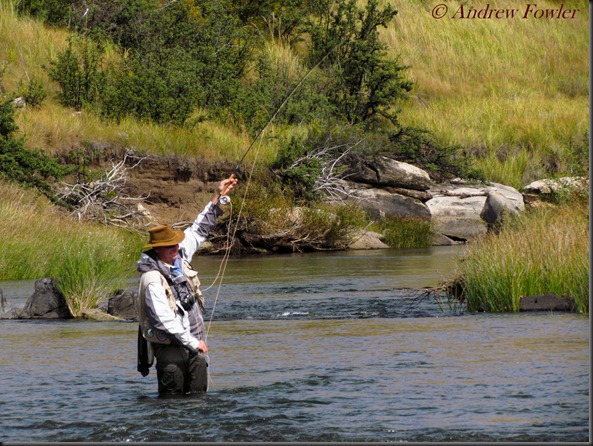
While he was catching fish, he was having one of those days, where he was battling to turn the fly over neatly at times, and he decided on a leader change, as part of a process of elimination. That is a sensible thing to do when you are having a “tangle-day”. You have tangled days too? Good: you are human like me.
Anyway, he changed to a tapered mono leader. Within half an hour he put the furled leader back on. It turns out it was probably the wind, or his reaction to it, that was the trouble, and the furled leader was in fact making things marginally better.
On the same day, I stopped around lunchtime, and took off the sodden furled leader, to change it for a freshly treated and dry one. (I need to explain: I make my furled leaders with fly-tying silk in them, so they do absorb some water over time). Usually this change is like a freshening up. It puts a spring in my step in a way. After lunch one is back on the water, with the leader floating high and dry, and some of the confidence of the first cast of the day is returned. But on this day, I did something I have never done before: I changed back to the sodden one!
Why, you may ask. Well it turns out that the sodden one had more weight, and as a result it was turning over fantastically in the wind. The dry one was as light as a feather in comparison, and I couldn’t get it to turn over in the face of the wind. Normally, and without a strong wind, the dry one would have been perfect.
All this got me thinking about my furled leaders, and I have an idea which I am going to try out. How about we make them heavier, drench them in something heavier, but that doesn’t affect the flotation too badly, or that perhaps prevents some water absorption, but which already carries the weight that would have been provided by the water. UV glue. In fact I already treat the leaders with a fine UV glue rubbed into the weave, but I plan on adding a bit more, especially near the tippet end. I first started adding the UV glue as a means of preventing individual threads pulling free when hooked with a fly, for example. I can highly recommend this treatment, especially around the loops at each end. I put some between my fingers, and quickly rub it up and down the length of the leader while rolling my fingers together, to work it in.
I first started making furled leaders back in 2000. I can’t claim any innovation on this one: we had a number of visiting anglers to the country, and one of those was Darrel Martin. Darrel was at an evening function for the local fly-fishing club, and he had a number of us line up, and hold out little plastic rods. Darrel then weaved back and forth, threading a fine nylon in and out. Then he had us pull the threads from the rods, and he stood at one end with a Dremel, while I timed him, and wound the thing up. It was a great party trick. At the end of the evening, Darrel handed out a small diagram explaining the recipe. I still have that little card.
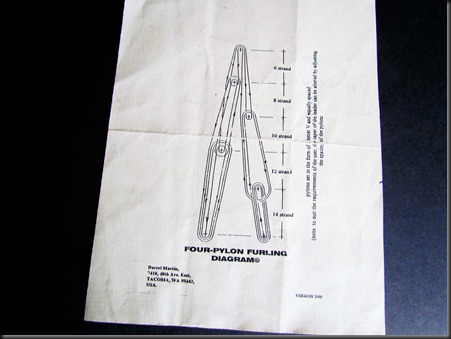
In the weeks and months that followed, I made up a board, and started experimenting with materials and formulas. Any one of us present at the event could have done it, but I suppose it grabbed my attention more than it did the other guys. I ended up actually making them in batches and selling them, complete with printed packaging, the lot.
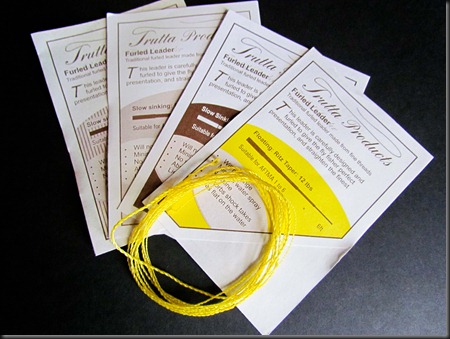
The problem was that I had a day job, and I couldn’t keep up with the manufacture and marketing and delivery, and it became clear I wasn’t going to get rich making furled leaders!
And so now I just make them up for my own use, and give them to fishing pals.
I use fly tying silk, as well as a very fine nylon thread which I buy at a haberdashery.
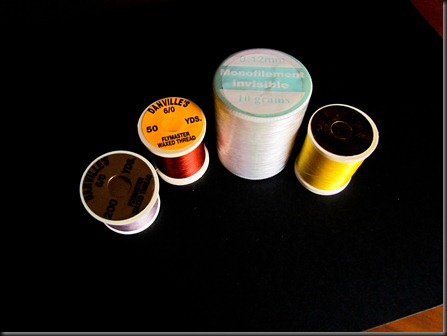
I found that the nylon alone was way too “tense”. That is the most descriptive word that comes to mind. By that I mean it was inclined to want to wind up on itself. There are some manufacturers who make them out of nylon or fluorocarbon alone. Ed Herbst once kindly sent me a lovely Mulligans “Whisper” leader, which was less “tense”than the ones I had made, but still a little too “wound up” for me.
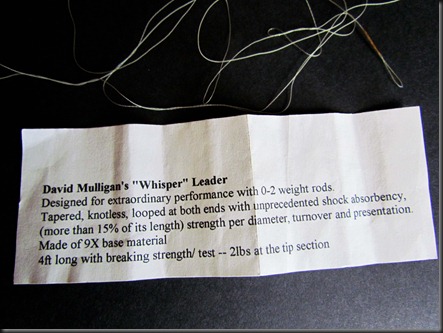
The fly tying silk is softer, but perhaps too soft if used on its own. So I use both together, to give a soft leader, but with an underlying backbone. And of course some UV Knotsense adds a little more backbone, and perhaps some of that weight I started out describing.
Some makers use a tippet loop on the fine end. I haven’t tried that. Instead I now attach a piece of 2X tippet permanently there, onto which I knot my tippet later. I just tie that on with an improved clinch knot. I used to use a loop at that end, but it closes, and becomes impossible to open. In fact I well remember an evening on the Sterkspruit where PD was sitting on a rock behind me trying to open the loop to put on a new tippet,while I caught fish after fish. He cursed me so badly that day, that I changed the design without delay!
On the thicker end I have always used a loop, but I only recently perfected it when I took apart a commercial furled leader and saw how they made the loop. They pass the naturally formed loop (that you inherently get during the process), through the weave, at a point about an inch down the leader. Then they passed the tippet end through that same loop, and pulled it through, leaving a secure loop that is neat and won’t close. Even this old dog can learn new tricks!
Colour: I make them bright yellow. I know that this gives you more opaque material closer to the fly, and I probably compensate for that by using a longer tippet (which the furled leader turns over with some ease). The benefit of the yellow, is that you can see it, and track where your fly is. This is perhaps not necessary when using a strike indicator, but I have become accustomed to following that slender yellow thread all day on the stream, and habits die hard.
Treatment: I rub some silicone paste onto the leader at the beginning of the day, before the leader gets wet. You want it floating high and dry on our small rivers and streams. The tippet will give you enough length of sunken material to get the fly down to where you want it.
The breaking strain of my leaders is probably around 12 pounds. I say probably, because not being an expert on these things, I don’t know how one should test breaking strain professionally. I once hung a bucket of stones on one end of the leader, and a scale on the other, and suspended the rig in the stairwell at home. I kept adding stones to the bucket until the leader snapped. I can’t remember the last weight it held, but I deducted a generous margin for safety, and decreed them safe to 12 pounds. I haven’t broken one out on the water yet.
One thing you must NOT do with a furled leader: When you hang up on a bush or tree, do not yank/tug/pull. The reason is that if, or when the fly comes free, the leader will wind up on itself in an awful mess when it springs back at you.
If you haven’t tried furled leaders yet, I would strongly recommend you do.
I see that Ben Smith at AZ Wanderings sells what look like really nicely made ones, and you can order from him online.
Some more useful resources on furled leaders:
- Global Fly Fisher
- Ed Hebst’s article on Rod Dibbles furled leaders (UK based)
- Hatches Magazine article on how to make them
- You could buy a book , but I don’t think that is necessary
- A UK supplier (randomly googled)
- A late entry on “for and against“
8 Responses
Nice piece and as a furled leader convert, I don’t take too much convincing. For what it’s worth, I think there will be a very fine line making leaders heavier and what will work and what won’t. I look forward to hearing the results in due course.
Agreed Peter, the weight will be a very fine line. In fact before replying to your comment I tried to weigh a heavily treated leader vs an untreated one, but alas my scale (which registers in increments of 1 gm) didn’t even know I had put something on it! I have access to a laboratory scale, so watch this space for some interesting feedback, but I suspect that when considering the force applied by ones cast, and the weight of the line, the actual dead weight of the leader may be an insignificant factor in measurable terms.
Sorry but I simply have to totally disagree on this subject because I strongly dislike furled leaders. Firstly they have mass, particularly when damp, as you quite rightly point out. This then simply makes them an extension of the fly line and not really a leader at all. I had a long discussion with master caster Peter Hayes whilst he was here and staying with me and he didn’t like them one jot either. I suppose one might argue that “one man’s meat” and all of that but personally I really have a strong aversion to furled leaders and my thoughts on the subject were reinforced by one of the best casters on the planet. I believe that the leader’s primary role is to bleed off casting energy and not to preserve it. Certainly you do preserve that energy with the furled leader but then you are still faced with the problem of bleeding it off again at some point so ultimately gain little. Faced with a strong downstream wind one might as well simply shorten the nylon leader as in effect adding a furled leader is simply extending the fly line and shortening the leader anyway, still just my opinion only , not the word of God but perhaps food for thought and an area worthy of further discussion and thanks for the thought provoking blog. Regards Tim
Thanks for your valued viewpoint Tim.
Interesting thoughts, for sure. You have me thinking I might give furled leaders another try, but only after giving a lot of thought to their composition. Normally, I use braided leaders, and I love them.
Just notice the trout map in the margin as well. Very cool.
I find that braided leaders have some of the supplety in the butt section, almost like a furled leader and more than a mono leader for sure (even a boiled one!), but I find they tend to spray water droplets, and I can’t get them to present as delicately as a furled leader. You will also get more stretch (shock absorbtion) from the furled than from the braided one. But at the end of the day, all the science and other people’s theories are of limited value. Even one’s own theories may be meaningless. It’s just about what works for you after many years of trial and error where it all matter: on the water. I for one, derive pleasure in trying these things, hearing peoples ideas, and forming my own opinion.
Good insights. Would you mind describing or sending me a diagram of how you do that loop in the line. Thanks, ahead.
Hi Norm. Thanks for dropping in to read. The loops at each end are not an addition. These form when you make the leader, based on how it is done. Here is a useful video to explain:
https://youtu.be/aeAn0o9TsRE?si=MEp9Q4Z_e3UGtg3D
(type that into your search bar while in YouTube)
Or look at the links at the end of the article.
I do hope this helps.
Best wishes